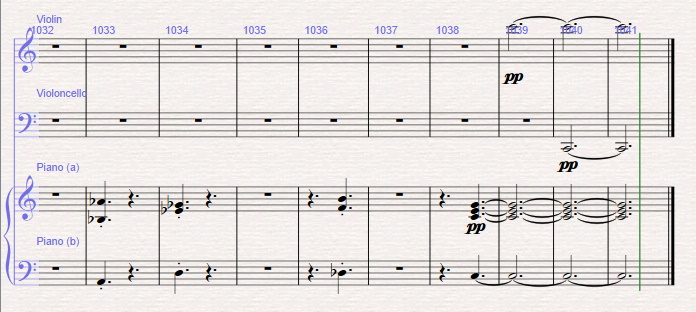
Op.83
| Date | Duration | Download | |
|---|---|---|---|
| 22'02" | Realization (.MP3) | Score (.PDF) | |
For fans of useless statistical minutae, I have been producing at exactly 25% efficiency this year, compared to typical previous years. I am tempted to blame the cabal of malignant morons currently running the world's affairs for this drop in productivity; but in truth none is directly to blame, save myself. More yoga and less cable news is the obvious remedy going forward, should I elect to follow that path.
A trio in one movement, containing twelve distinct, brief episodes. The root tone row itself is, of course, C-Db-F-G-Gb-D-B-Bb-Ab-A-E-Eb; however, I adjusted the putative harmonic plan in retrospect - inserting the episode based on G between the ones based on C and Db. This was done not for harmonic purposes, but for purely stylistic ones after reassessing the tempi and characters of the first five episodes' drafts. I promise to try to never commit such an egregious affront again, in future compositions.
While on the subject of egregious affronts, this composition offers a unique opportunity to comment on doubtless controversial aspects of my heretical theory of tonality (based solidly, if loosely, on a simplified version of Hindemith's own well-publicized investigations into the subject). I generally try to avoid extended theoretical discussions in ephemeral publication notes like these, but the set-up in this case is so obvious and glaring, that it deserves frank recognition. Some eagle-eyed future analyst is virtually certain to notice that the final notes in the concluding cadence of the very last measures of this composition clearly and indisputably form a C Major triad in the root position. How in Haydn's name can I positively assert in the face of such incontrovertible evidence that the tonal center of this Presto molto is ... Eb?

The solution to this seeming conundrum is to liberate oneself, finally and decisively, from the seductively beautiful shackles of long-common diatonic theory and recognize that (as Hindemith suggested) tonality has a scientific - and not merely a stylistic and conventional - basis. Generations of diatonic theorists have insisted one must firmly "establish" tonality by continual reference to a particular subset of über-pleasantly sonorous possible chord progressions, i.e., cadences, and that - above all - the final cadence in a piece must be a Perfect Authentic Cadence, ending with a tonic triad in the root position. This would be similar to maintaining that only the eight simplest atoms in the universe, hydrogen through oxygen, are the basis of all chemistry and that only chemical reactions involving these particular atoms are valid. Tonality does not need to be established; its potential exists in the overtone series contained within the vibrations of every musical note. In the Hindemithian tonal universe, every single interval (save the naked tritone) has an identifiable root; every possible chord has a clearly discernable root of roots; and every possible chord progression exhibits melodic root relationships among the various roots of the successive chords. Authentic cadences and other conventional diatonic progressions do not "establish" tonality; they only simplify it and make it thoroughly unambiguous, like the tedious melodies in children's songs.
Hindemith's hierarchy of root relationships in a nutshell: perfect fifths, both kinds of thirds and both kinds of sevenths are ruled by their lower tones; perfect fourths, both kinds of sixths and seconds, being inversions of the first three species of intervals, are ruled by their upper tones. Therefore, the first chord in the cadence above, which can be reduced to two minor seconds and a major second all stacked together, is clearly ruled by the Bb. In the second chord, the minor third in the upper interval and the minor second in the lower interval both point strongly to Eb as the unambiguous root. As Bb is the upper tone of a perfect fifth, Eb is thus obviously the overarching tonal center of the first two chords. The third chord is more abiguous, with the tritone in the treble clef, but the major third between the bass and the treble F point conclusively to Db as the root; Db being a major second below Eb leaves Eb still firmly in control of all three chords in the progression thus far. Finally, the indisputable C root of the last chord is the weaker lower tone of a minor second with the preceding Db, which is itself still controlled by the earlier Eb. Thus, the final cadence of the episode expresses an Eb tonality. Even the ultimately powerful root-position major triad at the very end cannot escape the gravity of the preceding Eb chord. It isn't simple and blaring like the nursery rhyme of a perfect authentic cadence; but it is real and arguably persuasive in its own right.
All this, without even once mentioning that the whole thing was built with a tone row. Almost as though the fact were irrelevant. As, in fact, it is.
|
Back to Selected Compositions |
| tokala.net |